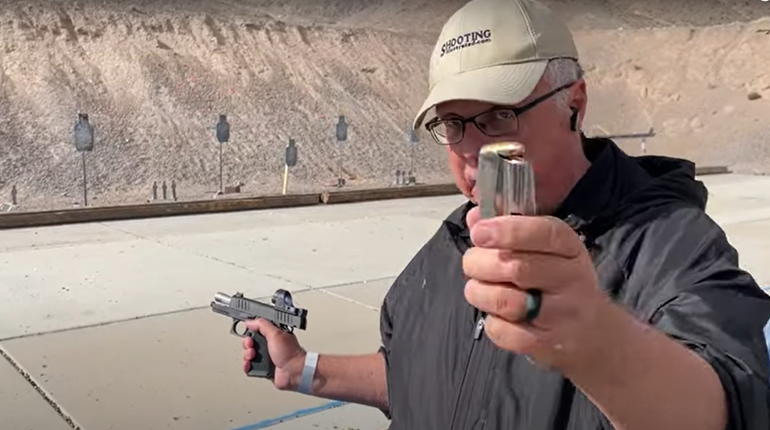
Kimber’s hunting rifles carry certain panache, owing to their controlled-round-feed bolts, well-balanced combinations of action and barrel contour, and graceful lines highlighted by either high-grade walnut or high-tech carbon-fiber composite. Yes, they’re lookers, but they’re also shooters that come with an accuracy guarantee. Just how important is upscale appearance to hunters in the market for a Kimber? The company will find out by way of the new Model 84M Hunter, the first Kimber rifle to wear an injection-molded stock, with a suggested retail price that’s $400 less than any other bolt gun in the manufacturer’s line.
Here is a case where inexpensive (that is, compared to the rest of Kimber’s rifles) doesn’t mean cheap. A current trend in hunting rifles has put some makers in a race to the bottom line, with companies developing new actions that are designed for faster manufacturing and assembly to lower the cost of production. Kimber doesn’t go that route with the Hunter, instead building the rifle on the same action the company uses for all its 84M variants. There is the same two-lug bolt featuring a full-length claw extractor, the same wing-style three-position safety and the same recoil lug washer positioned between the rear of the barrel and the front of the receiver. In addition, the Hunter’s barrel is like those found on the rest of the Kimber rifle family, having a match-grade chamber. To top it off, the barreled action is stainless steel, another feature not normally found on budget guns.
That leaves the stock, which is where Kimber saves on production costs. Polymer isn’t as pricey as grade-A French walnut or carbon fiber, but the company still puts substantial emphasis on both the quality and the function of the Hunter stock. It is the most well-designed polymer stock on any so-called entry-level rifle I’ve tested, but I admit to being partial to Kimber’s signature high comb and open grip. The Hunter has both, and it handles much like the company’s Montana and Mountain Ascent rifles because of these features.
The Hunter stock is downright rigid, thanks to the honeycomb grid molded into its fore-end and several integral cross-members in the receiver area that add strength. Rifle product engineer George Hawthorn developed the honeycomb design, noting the pattern “improves the stock’s strength-to-weight ratio and adds rigidity under torsional loading while not diminishing the rigidity in the major axial direction under load.” In other words, the fore-end resists twisting when pressure is applied to a bipod and counters flexing under recoil. Kimber says the Hunter stock is on par with the Montana’s carbon-fiber version in terms of stiffness.
Aluminum pillars support the action and permit the barrel to remain free-floating. The robust trigger guard is integral to the stock. Finally, the panels of molded-in stippling on the pistol grip and fore-end provide enough friction in hand to aid purchase without being gaudy. The Hunter stock is about as stylishly understated as polymer stocks come.
The Hunter includes another first for Kimber centerfire sporters: a detachable box magazine. It holds three rounds and rides flush with the belly of the stock. The body and feed lips are steel, while the base is polymer. A large, spring-loaded latch mates with a recess in the stock, and there are no annoying hang-ups between the two when rocking the magazine into place. Hawthorn worked on the magazine’s center-feed design, too, adjusting the feed lips so that they presented as much of the case head as possible while still allowing it to clear the stationary, blade-type ejector near the back of the receiver.
My test rifle with a 22-inch barrel chambered in 6.5 Creedmoor weighed less than 6 pounds, which is noteworthy for a bolt gun that should retail for about $850. It also had an excellent trigger that broke at 3.8 pounds with no creep. And, like all Kimber rifles, the Hunter came guaranteed to meet the company’s Sub-MOA Accuracy Standard for three-shot groups at 100 yards. Sound too good to be true? I thought the same thing but then noticed the two test targets included with the rifle. One group measured .64 inch, and the other measured .75. Both were fired with Hornady Match ammunition, and so I was curious to see how the Hunter would do with loads more fitting of its name. I found a winner with the Hornady Superformance 120-grain GMX load, which averaged .70 inch. The overall group average for four Hornady factory loads, including the company’s Match load with the ELD-M bullet, was 1.03 inches—good enough to prove the rifle was a sub-MOA shooter in my tests.
The Hunter is certainly the most utilitarian-looking sporter in the Kimber family, but I really don’t think that matters. Its performance, weight and price are what will command attention.
Technical Specifications
• Type: bolt-action centerfire rifle
• Caliber: .243 Win., .257 Roberts, 6.5 Creedmoor (tested), 7mm-08 Rem., .308 Win.
• Barrel: 22"; stainless steel; 4 grooves, 1:8" RH twist
• Trigger: single-stage, adjustable; 3.8-lb. pull weight
• Magazine: steel and polymer detachable box; 3-rnd. capacity
• Sights: none; receiver drilled and tapped for scope bases
• Safety: three-position wing
• Stock: straight comb; flat dark earth polymer w/aluminum pillar bedding; LOP 13.75"
• Metal Finish: stainless steel
• Overall Length: 41.25"
• Weight: 5.5 lbs.
• MSRP: $891




































